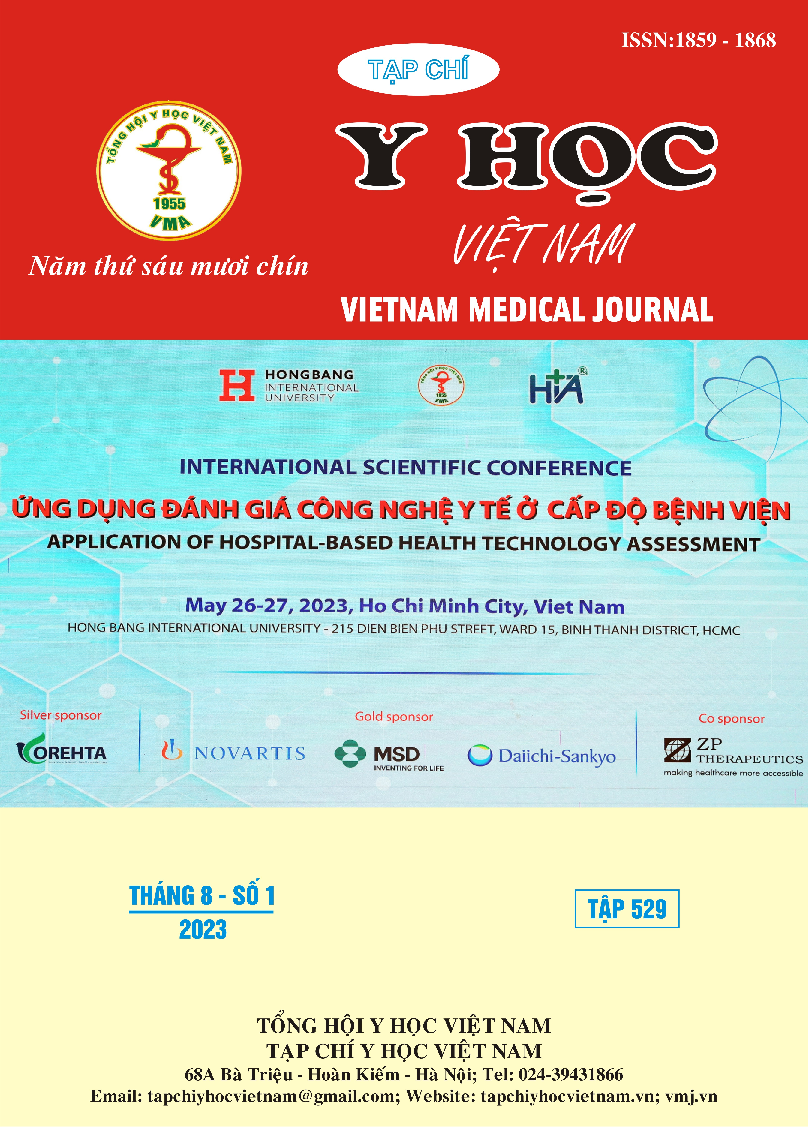ẢNH HƯỞNG CỦA SUY YẾU LÊN KẾT CỤC LÂM SÀNG Ở BỆNH NHÂN CAO TUỔI SAU THAY VAN ĐỘNG MẠCH CHỦ QUA ỐNG THÔNG
Nội dung chính của bài viết
Tóm tắt
Mở đầu: Thay van động mạch chủ qua ống thông là một giải pháp thay thế an toàn hơn phẫu thuật thay van và đã trở thành một lựa chọn điều trị phổ biến trong hẹp van động mạch chủ. Bệnh nhân cao tuổi có suy yếu dù được thay van động mạch chủ qua ống thông cũng có thể không thay đổi tiên lượng, thậm chí có nhiều kết cục xấu và tử vong cao hơn so với bệnh nhân không suy yếu. Mục tiêu: Xác định ảnh hưởng của suy yếu lên kết cục lâm sàng ở bệnh nhân cao tuổi sau thay van động mạch chủ qua ống thông tại Bệnh viện Vinmec Central Park. Đối tượng và phương pháp nghiên cứu: Nghiên cứu được thực hiện từ tháng 1 năm 2017 đến tháng 5 năm 2022, trên bệnh nhân cao tuổi hẹp khít van ĐMC có triệu chứng được thay van động mạch chủ qua ống thông. Đánh giá suy yếu sử dụng các chỉ số: nồng độ albumin huyết tương, tình trạng thiếu máu và hoạt động chức năng cơ bản hằng ngày theo thang điểm Katz. Về kết cục lâm sàng chung bao gồm tất cả biến cố xảy ra sau thay van động mạch chủ qua ống thông 1 tháng, 6 tháng và 12 tháng. Kiểm định mối liên quan giữa suy yếu và kết cục lâm sàng chung bằng hồi quy logistic, sự khác biệt có ý nghĩa thống kê với p<0,05. Kết quả: Nghiên cứu thu thập được 73 bệnh nhân cao tuổi, với tuổi trung vị là 69 (62 – 76). Kết cục lâm sàng chung (thất bại thủ thuật, biến chứng mạch máu, chảy máu nặng, đột quỵ, tổn thương thận cấp, đặt máy tạo nhịp và tử vong) sau 1 tháng, 6 tháng và 12 tháng lần lượt là 34,25%, 36,99% và 38,36%. Bệnh nhân có 3 chỉ số suy yếu bất thường tăng khả năng xảy ra các kết cục lâm sàng bất lợi sau 1 tháng, 6 tháng và 12 tháng (lần lượt p = 0,030, p = 0,036 và p = 0,024). Kết luận: Bước đầu cho thấy bệnh nhân cao tuổi hạn chế hoạt động chức năng cơ bản hằng ngày, nồng độ albumin thấp và thiếu máu có mối liên quan đến tăng khả năng xảy ra kết cục lâm sàng bất lợi sau thay van động mạch chủ qua ống thông 1 tháng, 6 tháng và 12 tháng.
Chi tiết bài viết
Từ khóa
thay van động mạch chủ qua ống thông, suy yếu, người cao tuổi, kết cục lâm sàng
Tài liệu tham khảo
1. Iung Bernard, Vahanian A. Epidemiology of valvular heart disease in the adult. 2011;8(3):pp. 162.
2. Roberta A, Salvatore C P. Epidemiology of aortic valve stenosis (AS) and of aortic valve incompetence (AI): is the prevalence of AS/AI similar in different parts of the world? e-Journal of Cardiology Practice. 2020;18(10).
3. Pellikka P A, Sarano M E, Nishimura R A, et al. Outcome of 622 adults with asymptomatic, hemodynamically significant aortic stenosis during prolonged follow-up. Circulation. Jun 21 2005;111(24):pp. 3290-5.
4. Ross J Jr, Braunwald E. Aortic stenosis. Circulation. Jul 1968;38(1 Suppl):pp. 61-7.
5. Horstkotte D, Loogen F. The natural history of aortic valve stenosis. European Heart Journal. 1988;9(suppl_E):pp. 57-64.
6. Nishimura R A, Otto C M, Bonow R O, et al. 2014 AHA/ACC Guideline for the Management of Patients With Valvular Heart Disease: a report of the American College of Cardiology/American Heart Association Task Force on Practice Guidelines. Circulation. Jun 10 2014;129(23):pp. e521-643.
7. Smith C R, Leon M B, Mack M J, et al. Transcatheter versus surgical aortic-valve replacement in high-risk patients. The New England journal of medicine. Jun 9 2011;364(23):pp. 2187-98.
8. Leon M B, Smith C R, Mack M J, et al. Transcatheter or Surgical Aortic-Valve Replacement in Intermediate-Risk Patients. The New England journal of medicine. Apr 28 2016;374(17):pp. 1609-20.
9. Reardon M J, Van Mieghem N M, Popma J J, et al. Surgical or Transcatheter Aortic-Valve Replacement in Intermediate-Risk Patients. The New England journal of medicine. Apr 6 2017;376(14):pp. 1321-1331.
10. Baron S J, Arnold S V, Wang K, et al. Health status benefits of transcatheter vs surgical aortic valve replacement in patients with severe aortic stenosis at intermediate surgical risk: results from the PARTNER 2 randomized clinical trial. 2017;2(8):pp. 837-845.


